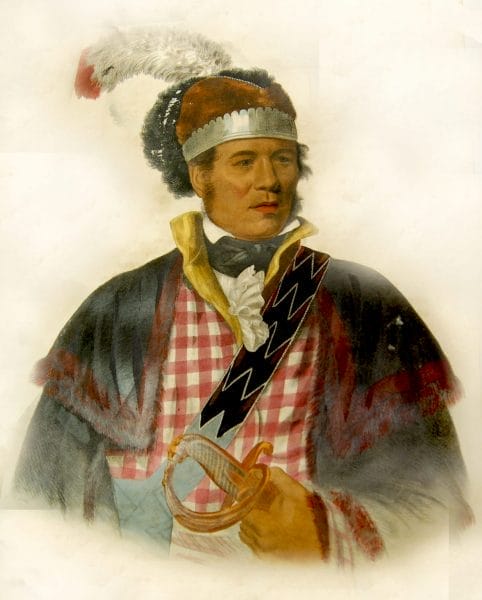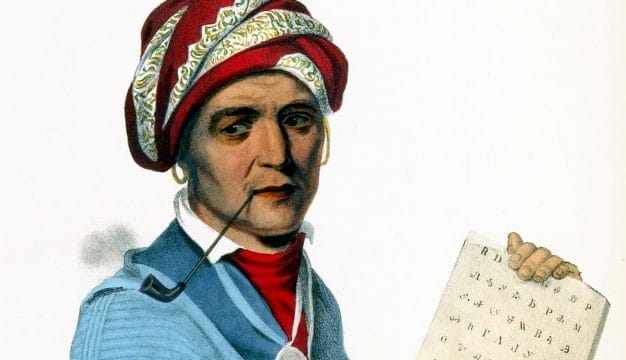Treaty of Indian Springs (1821)
The First Treaty of Indian Springs, or more formally the Treaty with the Creeks, 1821, entailed the Creeks ceding their remaining land east of the Flint River in Georgia to the United States. The treaty made the Creek National Council even more determined to cede no more land. The treaty was signed on January 8, 1821, at Indian Springs, Georgia.
 William McIntosh
Treaty talks, which began in December 1820 at an inn owned by Lower Creek headman William McIntosh, involved representatives from the federal government, Georgia, and more than 20 Creeks led by McIntosh and Tustunnugee Hopoie (Little Prince). The talks had several purposes. Georgia representatives, who had called the meetings, wished to obtain land in the northern part of the state that would separate the Creeks from the Cherokees to decrease the likelihood of their becoming allies. In addition, Georgia citizens had lodged some $350,000 in unpaid claims against the Creeks for trade transactions going back several decades and aimed to recoup those debts, which were most likely inflated. The commissioners representing the federal government also hoped to obtain land and to convince the Creeks displaced from the ceded land to relocate west of the Mississippi. One proposal would offer the Creeks a tract of land in what was known as the Quapaw Cession in northern Louisiana and the Arkansas Territory, which the Quapaws had ceded in 1818 and which had recently been given to the Choctaws. During the talks, Georgia commissioners also pressed the Creeks to abide by the terms of earlier treaties, which required them to return property, including runaway slaves and horses, to their owners. McIntosh defended the Creeks against the charges, noting that many of the escaped enslaved people were not among the Creeks; he also encouraged lenience for debtors.
William McIntosh
Treaty talks, which began in December 1820 at an inn owned by Lower Creek headman William McIntosh, involved representatives from the federal government, Georgia, and more than 20 Creeks led by McIntosh and Tustunnugee Hopoie (Little Prince). The talks had several purposes. Georgia representatives, who had called the meetings, wished to obtain land in the northern part of the state that would separate the Creeks from the Cherokees to decrease the likelihood of their becoming allies. In addition, Georgia citizens had lodged some $350,000 in unpaid claims against the Creeks for trade transactions going back several decades and aimed to recoup those debts, which were most likely inflated. The commissioners representing the federal government also hoped to obtain land and to convince the Creeks displaced from the ceded land to relocate west of the Mississippi. One proposal would offer the Creeks a tract of land in what was known as the Quapaw Cession in northern Louisiana and the Arkansas Territory, which the Quapaws had ceded in 1818 and which had recently been given to the Choctaws. During the talks, Georgia commissioners also pressed the Creeks to abide by the terms of earlier treaties, which required them to return property, including runaway slaves and horses, to their owners. McIntosh defended the Creeks against the charges, noting that many of the escaped enslaved people were not among the Creeks; he also encouraged lenience for debtors.
Ultimately, the Creeks refused to cede land between themselves and the Cherokees and refused to move west. The Creeks did agree to part with a tract of land that bordered the Flint River to the west and the Ocmulgee River to the east and that stretched north to a point near Alpharetta, just above present-day Atlanta. It was contiguous with the acreage acquired in the First Treaty of Washington and helped further secure the Federal Road. The tract was estimated at more than 6,700 square miles, or approximately 4.3 million acres. Although the cession was large, it was not considered important by the Creeks, as game had been largely driven away by white settlement. In return for the land, the United States agreed to pay the Creeks $10,000 outright at the signing and $40,000 after the accord was ratified. In addition, the federal government agreed to pay $5,000 a year for the following two years, $16,000 annually for five years thereafter, and $10,000 annually for six years after that. The sum totaled $200,000 and the treaty stated it would be paid over 14 years in cash, or goods and farm implements, at the discretion of the Creeks. Also, the various parties agreed upon a sum of $250,000 in Creek debt, which the federal government agreed to pay under a separate document also known as “Treaty with the Creeks, 1821,” signed that day. However, ultimately only about $100,000 was reportedly paid out to Georgia claimants.
Having overseen the negotiations on the Creek side, McIntosh was the primary beneficiary of these payments. He received a $40,000 payment for his assistance in arranging previous agreements and some sources say he received the funds from the treaty to distribute to his supporters, which would have further strengthened his position of leadership. The treaty also awarded McIntosh 1,000 acres surrounding Indian Springs and an additional 640-acre tract of land around his plantation on the Ocmulgee River. Members of the Bernard family and leader Efau Imathla (Efauemathlaw in the treaty text) obtained one-square-mile tracts, with the proviso that they had to reside on the tracts.
Because of this treaty, the Creek National Council resolved never to sell or barter away any more of their ancestral land. The council already had outlawed such acts, but had suspended the law for the 1821 treaty. In 1825, however, accompanied by approximately 50 Creeks including a handful of headmen, McIntosh signed away the remaining Creek land in Georgia to the state in the Second Treaty of Indian Springs. That treaty was later nullified, and McIntosh was sentenced to death by the Creek National Council and executed for his role in the illegal treaty negotiations.
Further Reading
- Green, Michael D. The Politics of Indian Removal: Creek Government and Society in Crisis. Lincoln: University of Nebraska Press, 1982.
- Griffith, Benjamin W., Jr. McIntosh and Weatherford: Creek Indian Leaders. Tuscaloosa: University of Alabama Press, 1988.



